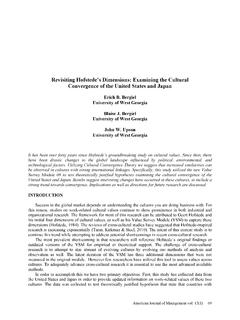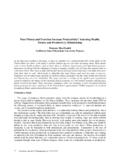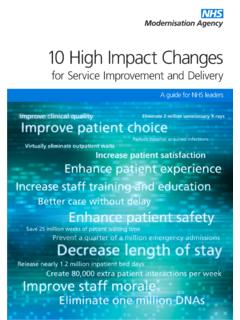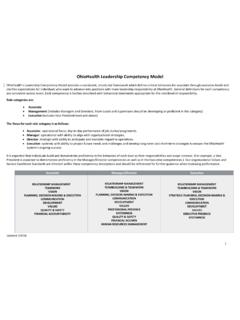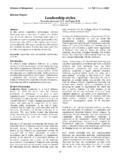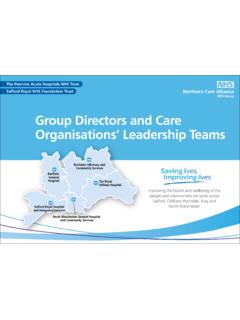Transcription of High Performance Executive Teams
1 high Performance Executive Teams Sonia Taneja Texas A&M University-Commerce Scott Sewell Texas A&M University-Commerce Mildred Golden Pryor Texas A&M University-Commerce Strategically and tactically, organizational leaders often establish Teams to accomplish the missions, visions, goals and objectives of their respective organizations. Teams exist in all types of organizations including financial institutions, factories, healthcare organizations, and educational institutions. Yet executives often struggle to maintain high Performance of their own leadership Teams . This research seeks to answer several questions, including: (1) What are the characteristics of a high Performance Executive team ?
2 (2) What problems do Executive Teams face that negatively impact their potential for high Performance ? And (3) What can executives do to increase their respective Teams potential for high Performance ? INTRODUCTION Holmes (2012) recognized that organizations are changing from traditional hierarchical work structures to team -based approaches to work. He noted that high - Performance Teams must develop goals and plans, enhance communication among members, develop and maintain positive relationships among members, solve problems and make decisions on a timely basis, successfully manage conflict, facilitate productive meetings, clarify roles for team members, operate in a productive manner, exhibit effective team leadership, provide development opportunities for team members (Holmes, 2012, ).
3 These ten actions are critical in order to form a successful team . Authors of other publications in the area of effective, high Performance Teams (Rico, Sanchez-Manzanares, Gil, and Gibson, 2008; Harrison and Tarter, 2007; Adobor, 2004; Munro and Laiken, 2003; Ammeter and Dukerich, 2002; Pryor, 1993, 1998, 2007; and Pryor, Singleton, Taneja, and Toombs, 2009) also emphasized that it is important to establish missions, visions, goals, and strategies because they act as catalyst for the success of Teams and are building blocks for the development and long term survival of an organization. American Journal of Management vol.
4 12(2/3) 2012 11 CHARACTERISTICS OF high Performance Teams Teams cannot be effectively measured as a success or failure unless it is united together for a common purpose or a common goal (Robbins, 2005). In fact, a group without a common goal is really not functioning as a team and would be more likely to fail because it has no unified direction. Teams that have demonstrated that Performance excellence is their way of life are high Performance Teams . Along that line, Kur (1996) defines high Performance Teams as Teams that consistently satisfy the needs of customers, employees, investors and others in their respective areas of influence.
5 And frequently outperform other Teams that produce similar products and services under similar conditions and constraints (p. 34). high Performance Teams must be created (Richardson and Denton, 2005), and there are specific strategies, tactics, and actions that can increase the probability that Teams will be high Performance (Leholm and Vlasin, 2006; Harris, 2003). While all types of Teams should strive to become high performances Teams , it is especially critical that natural work Teams (including Executive leadership Teams ) make long-term commitments to excellence and high Performance . Yet as noted by Caska, et al (2001) and suggested earlier by Katzenbach and Smith (1993) high Performance Teams are a rarity.
6 Perhaps one explanation is that a high Performance culture must exist in high Performance Teams are to be the norm in an organization (Kaliprasad, 2006). McKnight (2009) noted, Top Teams exist to support the organization, to grow its assets by enabling it to produce value. In the most successful companies, the top team does this not only by creating the organization s business strategy but also by collaboratively executing that plan , marshaling the resources required to achieve those goals. This means building or maintaining the organizational capabilities (needed for executing) the strategy (p. 31).
7 These Teams are responsible for taking actions that will help the organization to achieve its goals. These top level high Performance Teams which consist of executives, CEO s, vice presidents, and others achieve success by developing contact with people (inside & outside the organization) to achieve the target, exert influence to get tasks accomplished, and finally direct and empower employees to work toward a common goal. The important role of the high Performance Executive team is to establish and maintain positive relationships with other team members in the organization because the effectiveness of have a direct impact on the overall success of an organization (The CV Centre, 2011, ).
8 These positive relationships help to build trust within a team and can ensure that people feel comfortable with airing their concerns or issues (The CV Centre, 2011). Forming trust within a team will encourage team members to assist each other in working toward team goals instead of focusing only on their respective individual agenda. Positive relationships instill a sense of community within the team , encourage open and honest dialogue, encourage a more overall positive experience, and usually enhance the team s capability for success. In order for team members to make critical decisions, it is imperative for them to have enhanced communication.
9 In a recent study conducted in the medical field it was found that communication failures are the leading causes of inadvertent patient harm resulting in the death of 75% of the patients harmed from miscommunication (Leonard, Graham & Bonacum, 2004, pg. 1). Looking at groups of people in the medical field as Teams with a goal of keeping patients alive and healthy, it is obvious that even if team members have clear goals, effective communication is needed from the formation of the goals until they are achieved. Otherwise, there could be drastic consequences. Unclear communication can be just as dangerous to the attainment of a goal as any other threat.
10 It is important to recognize that many factors contribute to communication failures (Leonard, Graham & Bonacum, 2004, pg. 1). In the example from the medical field, it was noted that doctors and nurses are trained to communicate quite differently (example of ineffective communication), hierarchy, or power distance, frequently inhibits people from speaking up , a present cultural barrier made communication more challenging, and other human factors contributed to ineffective communication that created inadvertent patient harm (Leonard, Graham& Bonacum, 2004, pg. 2). The establishment of productive, consistent communication would help avoid many of these problems.



